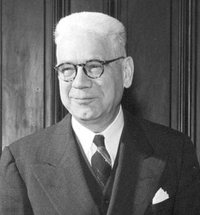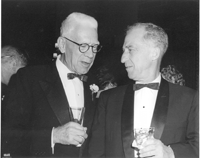Stuart Arthur Rice: Student Activist to Statistical Statesman
The following appeared in the October 1969 issue of The American Statistician.
Stuart Arthur Rice, president of the American Statistical Association in 1933, was born in Wadena, Minnesota, November 21, 1889. He earned an AB degree from the University of Washington in 1912 and a PhD in sociology from Columbia University in 1924.Rice’s career can, in one sense, be epitomized as the evolution of a student activist and young radical political party worker to social worker, to student and teacher of sociology, to statistician and statistical statesman. In another sense, his career epitomized the development of social and governmental statistics since the 1920s.
As an undergraduate in Seattle, he switched from the school of engineering to major in political science under J. Allen Smith, an exponent of the “economic basis of politics.” On graduating, he served briefly on the staff of the Washington State Industrial Welfare Commission, after which he became a confidential investigator for the New York City Department of Public Charities. Masquerading as a derelict, he sought refuge in the municipal lodging house for homeless men. His exposure to abuses in that institution led to his appointment at the age of 27 as its director.
During and immediately after World War I (being then a conscientious objector to military service—a stance he emphatically repudiated in later years), he worked for the War Camp Community Service and American Red Cross. In 1920, he returned to Seattle and resumed political activity as executive secretary of the local Farmer-Labor Party, unsuccessfully campaigning for the nomination of Robert M. LaFollette Sr. as the party’s candidate for president.
The following is an excerpt from an oral history interview with Stuart Rice’s wife, Sarah Mayfield Rice, on August 20, 1970. To read more about their social and political life in Washington, DC, during the Truman years, visit the Truman library archives.
I met my husband at The University of Chicago. He was my statistics professor for three quarters, and he scarcely seemed to know me, for at that time, he was engaged to Elizabeth Meade, the younger sister of Margaret Meade, the well-known anthropologist. … We went to the theater once, and once we drove out to the dunes and went swimming, but he didn’t get interested in me really until that following winter when I was back in Birmingham and he used to fly down on the weekends. … Stuart and I were married on May 29, 1934, and had a very lovely wedding and went to Europe for two months on our honeymoon.
Disillusioned by the break-up of the political coalition of disaffected farmers, industrial laborers, and white-collar workers, Rice returned to New York and enrolled as a graduate student of sociology at Columbia. Long afterward, he wrote of this turning point in his career: “My matriculation in sociology … was a confession of failure, a search for freedom from illusions. … I wanted to abandon preconceptions and to learn what makes the world ‘tick,’ rejecting in the search everything but demonstrable evidence and objective analysis … finding the truth and taking the consequences.”
Professor Franklin H. Giddings challenged Rice to find out why his political endeavors had failed; the resulting doctoral dissertation, “Farmers and Workers in American Politics,” stands as a landmark in the statistical analysis of political behavior. The former young agitator had now become what one of his close associates of the time has called “a pragmatic theorist.”
In the latter role, Rice taught sociology at Dartmouth College from 1923–1926 and was professor of sociology and statistics at the University of Pennsylvania until 1940. The 1930s saw his activities extend rapidly beyond the academic campus. In 1931, he joined the staff of the Social Science Research Council; during the ensuing years, he served on several of the council’s research committees and was a member of its board of directors. Methods in the Social Sciences, a volume edited by Rice under the council’s auspices and published in 1931, was a significant product of the council’s effort to foster more objective and verifiable research. Around the same time, Rice participated in the pioneering work of the President’s (Hoover) Committee on Social Trends, which was charged with making a comprehensive inventory of social trends in a nation staggering under the impact of economic depression. The growing need for more adequate statistical data, which that committee’s studies made sharply evident, led the Social Science Research Council and American Statistical Association to join in creating a Committee on Government Statistics and Information Services (COGSIS).
Originally called the National Labor Party, the Farmer-Labor Party—formed in 1919—changed its name to appeal to farmers. The party called for the public ownership of railroads, utilities, and natural resources; an end to private banking; and the nationalization of unused land.
In 1933, Rice assumed three positions, all related to his future work: president of the American Statistical Association, acting chair of COGSIS, and assistant director of the U.S. Census Bureau. He continued in the last of these positions until 1936, bearing responsibility for the bureau’s technical operations and working vigorously to raise the standards of professional competence of the staff of a traditionally patronage-plagued agency.
Largely through the influence of COGSIS, the Central Statistical Board was created by presidential order in 1936, and Rice left the U.S. Census Bureau to become its chair and executive head. The board’s mission was to improve the effectiveness of statistical work throughout the many agencies of the executive branch of the government—a mission that, in the absence of specific statutory authority, called for a high degree of tact and persuasiveness. Four years later, the board was supplanted by the newly created division (later office) of Statistical Standards in the Bureau of the Budget, and Rice was appointed the bureau’s assistant director for statistical standards, remaining in that post until his retirement from government service in 1955.
When the organization for the United Nations took form, Rice almost single-handedly laid the foundation for its Statistical Commission and Statistical Office. From 1945 onward, much of his time and energy were occupied in consultant service to foreign governments. He was responsible for reorganizing the statistical services of Japan during the American occupation of that country; he advised a number of western European governments in the immediate post-war years; and, from 1958–1963, he was statistical adviser to the government of Korea. As a member of the United Nations Contributions Committee, he was influential in bringing about a more equitable balance between the assessments levied on the USSR and on other nations—a feat involving no little diplomatic skill.
Rice’s contributions to international comity were not confined to the technical realm. During their stay in Korea, he and his wife “adopted” a number of young Koreans, some of whom they helped to come to the United States for higher education.
Retirement from federal service in 1955 did not mean cessation of activity. Rice continued for a decade to head the consultant organization known first as Stuart A. Rice Associates and later as Surveys and Research Corporation. After relinquishing the reins, he remained an active consultant to the organization in his last years. He also continued to participate in scientific gatherings, and a few months before his death in June 1969, he presented a critique of a report called “Lessons from the First Social Report and Thoughts for the Future.”
Among his list of numerous honorary awards, Rice received the District of Columbia Sociological Society’s Certificate of Merit in 1968 for “representing the best in public service and excellence in social science inquiry for more than 50 years.”



















